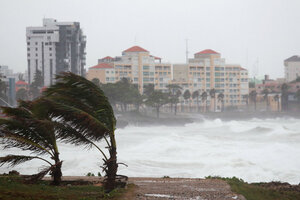Why researchers are concerned about 'grey swan' hurricanes
Scientists are working to quantify the risk of exceptionally devastating hurricanes. While such events are extremely rare, researchers encourage city planners and officials to prepare for storm surges far beyond what they have previously seen.

Waves crash along the shores of the Malecon in Santo Domingo, Dominican Republic, Friday.
Ricardo Rojas/Reuters
Tampa hasn’t experienced a major tropical storm since 1921, but a new study has put city planners there on notice.
Researchers at Princeton and the Massachusetts Institute of Technology named the city in a new paper that warns of potentially devastating storms they’ve dubbed "grey swans." Unlike Black Swans, which are truly unpredictable events, grey swans are highly unlikely but can be predicted with a degree of confidence.
"We are considering extreme cases," Ning Lin, an assistant professor of civil and environmental engineering at Princeton, said in a statement. "These are relevant for policy making and planning, especially for critical infrastructure and nuclear power plants."
Professor Lin teamed up with Kerry Emanuel, a professor of atmospheric science at MIT, to create computer models to examine potential storm hazards for three cities: Tampa; Cairns, Australia; and Dubai, United Arab Emirates.
Their findings, published Monday in the journal Nature Climate Change, show that powerful storms could generate devastating storm surges in all three cities.
Tampa is at particular risk in the United States because it sits on low-lying land surrounded by a bay of shallow water, reports Smithsonian Magazine. After plugging in Tampa Bay’s historical climate data from 1980 to 2005, the researchers ran 7,000 simulated hurricanes in the area. Their model showed that a grey swan storm could create surges of up to 18 feet tall, well higher than the 11-foot surges generated in the 1921 storm.
Professor Emanuel told The Washington Post that the purpose of the study was “to raise awareness of what a very low probability, very high impact hurricane event might look like.” But he and Lin both concede that such super storms are highly unlikely. Under current climate conditions, they have about a 1 in 10,000 chance of occurring in an average year.
“With climate change, these probabilities can increase significantly,” they write in the paper. For Tampa, those odds increase to between 1 in 3,000 and 1 in 1,100 by 2050 and between 1 in 2,500 and 1 in 700 by the end of the century.
Lin told Smithsonian that it’s important to predict the extremes and then “prepare for them as much as we can rather than wait for the consequences.”

